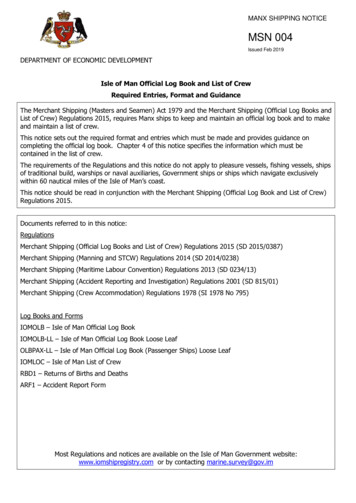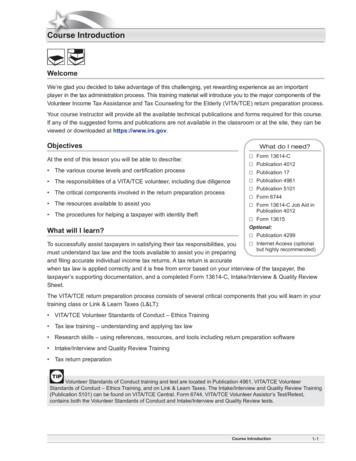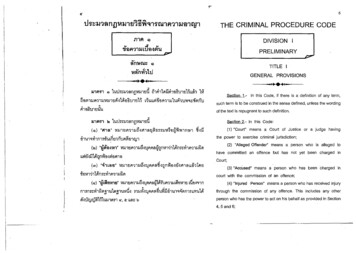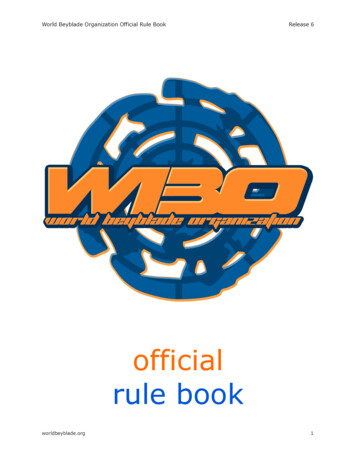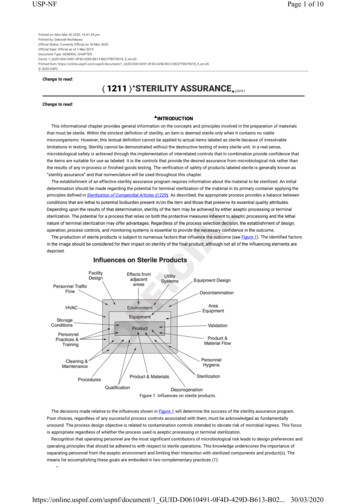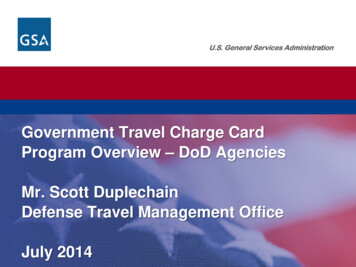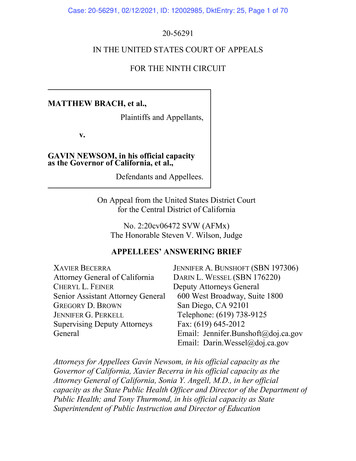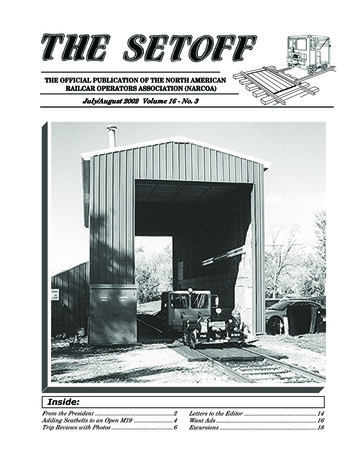
Transcription
THE SETOFF July/August Page 1THE OFFICIAL PUBLICATION OF THE NORTH AMERICANRAILCAR OPERATORS ASSOCIATION (NARCOA)July/August 2002 Volume 16 - No. 3Inside:From the President . 2Adding Seatbelts to an Open M19 . 4Trip Reviews with Photos . 6Letters to the Editor . 14Want Ads . 16Excursions . 18
Page 2 THE SETOFF July/August 2002From the Observation carRon ZammitPlease submitmaterialsfor the July/August issue ofTHE SETOFFby August 28as follows:Classified AdsExcursion AnnouncementsBill Coulson2101 Westview CourtModesto CA 95358–1091wcoulson@softcom.netLetters to the EditorAll other MaterialsPhotosJan Taylor917 Park View WayMissoula MT 59803jtaylor@montana.comCover PhotoJim Lindholm’s MT19and Jeremy Winkworth’s M19 at theengine facility on theCoopersville & MarneRailroad, November2001.As you know, this is to be my final column, although I do wish toexplore some thoughts on safety in the next issue—I still do not havethat article written yet. The Fall meeting is in late October (25th, 26th,and 27th), so there will be one more issue of THE SETOFF where I’llsubmit it.This is a simple “thank you” piece. First I’d like to thank all members who helped in the last decade. Many, many folks helped makeNARCOA and the hobby into an established part of the railroad scene,and I personally appreciate all the thanks I’ve gotten over the yearsfor my work. There are, however, folks who may not have gotten theirshare of thanks, and I’d like to attempt that now. I hope you will joinme by introducing yourself and saying a few words next time you seeone of these guys on the rails.There are some people who were (and still are in some cases) essential to NARCOA. Without any one or more of this group of five, wewould not have come nearly as far. They had the vision and the dedication to carry NARCOA forward. They are:Joel Williams. In my head, he’s Mr. NARCOA. He alone, for years,carried all the duties for the group, except editor. When I came onboard, he was pretty much doing everything, and he’s been part ofNARCOA since the beginning of the corporation. He’s still doing a lotof work for us as Secretary.Tom Norman. I think you all know what an incredible job Tomdoes. Years ago, the insurance situation was a mess, and it will always be a tough issue, but Tom has been there for us. His skills havepulled us out of some horrible spots.Hank Brown. He’s “the man” when it comes to setting up a run.Just like no one will ride as much track as Frimbo, I don’t think anyone will top Hank’s record on new runs and new rail. Additionally—and this is so important—Hank is totally open with his contacts, giving NARCOA affiliates a huge base of “open” track.Jack Whitt. I can think of no one who could make the first attempts at judiciary policy work. Jack did it, mainly because hisintegrety is unquestioned. It has be a gratifying thing to see his earlywork continue to make our Judiciary Committee function. I feel it hasbeen extremely important to “self police” and do it well, or we will be“policed” by outsiders. Jack got this operational.Mike Paul. His contributions and attention to detail regarding ourbylaws have been fundamental in making NARCOA work.Next there are some folks who have allowed me to consult withthem over the years to help me keep my focus on what to do. I’m surethey did not always understand what I was doing, but they werestraight with advice and helped in various rough spots over the years.These folks are Denny Anspach, Dave Verzi, Doug and Rich Stivers,Dana Fuller, and John Smith. I thank all of you.Finally, I’d like to thank all the wives, or significant others of thosewho worked so hard in the beginning. I’d especially like to thank mywife Kay whose patience and understanding with all those long distance calls and bills supported me regardless of how crazy it all seemed.Thanks to you all.Ron
THE SETOFF July/August Page 3Submitting Materialsfor Publication1Our editorial policy is to publish in T H ESETOFF all materials received, althoughthey may be subject to editing for spaceconsiderations.From Crerar, Adams& Co. catlog, 1903JACK HOOVER COLLECTION23Photos and materials submitted for publication in THE SETOFF cannot be returned, because they are archived.Letters to the Editor of the THE SETOFFwill not be published unless they are signed,and a phone number is indicated. This permits THE SETOFF Editor to authenticatethat a letter is written by the person signing. The letter writer can, however, requestthat his/her name not appear in THE SETOFF; “Name with held upon request” wouldappear in such instances.4Submit either black and white or sharp, colorprints for publication. Please label the backof the picture as to its subject matter andphotographer. Do not send slides.5We cannot publish copyrighted materialssuch as photos, posters, cartoons or articleswithout written permission from the authoror publisher. Sender must provide writtenpermission at the time of submission.6Excursion stories, technical articles, andlengthy submissions should be typed orprinted. Ads, meet notices and short articlesmay be handwritten. Please include yourphone number with your submission––evenwith E–mail––in case we need to clarifysomething we don’t under stand.7Send materials to THE SETOFF editorby the 28th of February, April, June, August, October or December for publicationthe following two–month edition.THE SETOFFVolume 16 Number 3Board of Directors ElectionTHE SETOFFEditorJan Taylor917 Park View WayMissoula MT 59803jtaylor@montana.comTHE SETOFFPublisherErnie Jeschke4106 N. Adrian Hwy.Adrian MI 49221ejeske@tc3net.comNARCOAMembershipJoel WilliamsBox 802Lock Haven, PA 17745joel.williams@horizonpcs.comResults of the election for Area Representatives were not available at press time.Last Minute AnnouncementKankakee, Beaverville & Southern RailroadSunday September 8, 2002GLRJoin us for a motor car excursion over the lines of the KB&S Railroad. We willmake a 90–mile circle tour of the railroad. Setting on at 7:00 A.M. in Donavan,Illinois and departing at 8:15 A.M. We will head southeast via the ex–New YorkCentral line to Templeton, Indiana. At Templeton we will head west on the exNickle Plate line to the junction of the ex–Milwaukee Road line at Chenneyville,Illinois. Turning north at Chenneyville we will follow the ex–Milwaukee tracks tothe KB&S engine house where we will retrace our route back to the set on point.All NARCOA rules and insurance requirements will apply. Cost will be 75 per carwith a limit of 35 cars. Send your Great Lakes Railcar registration form withpayment to Fred Lonnes, PO Box 92 Western Springs, Illinois 60558-0092 oremail at lonnesfd@flash.net.THE SETOFF is the official publication of the North American Railcar Operators Association (NARCOA) and ispublished bimonthly to promote safe operation of railroad motorcars and toencourage fellowship and exchange ofinformation among motorcar enthusiasts. Membership in NARCOA, which includes a subscription to THE SETOFF,is 20.00 per year and is available fromMembership Secretary Joel Williams.Please address all membership inquiresto Joel at the above address.Visit NARCOA’s Website at:http://www.NARCOA.org
Page 4 THE SETOFF July/August 2002Adding Seat Belts to an Open M19by Jeremy WinkworthAs the person who summarizes incident reports for publication inI have read about enough accidents where seat beltssaved the occupants of a motor car from flying out and meeting theballast, or worse. I was thus interested in adding seat belts to my openM19 but didn’t want them to look like the proverbial “dogs dinner.”How then to add function seat belts that don’t flop around?Greg Latz tipped me off that JC Whitney sells a good retractablelap belt, made in Elkhart, Indiana that might do the job. It’s catalognumber 81ZX4778R, currently 24.99 per belt plus shipping. I investedin a couple of these belts and then started figuring out how best tomount them. You want them attached to the frame for maximum safety.T H E SETOFF,I found a way to make some appropriate brackets to attach the belts to the frame by bendingsome 3/16" x 2" steel stock. You can see the belts and the the brackets below. On the left isthe belt and bracket for the outside of the seat, the right for the inside. The belt on the righthas the retractor in it.
THE SETOFF July/August Page 5Here’s a shot of how the belts attached to thosebrackets. The two 3/8" bolts at bottom left gothrough the outside frame member below the seat.The 7/16" bolt at bottom right goes through thefloor pan and the rear frame member under thefloor. If you don’t quite hit the rear frame member,reinforce the floor at that location and use as largea fender washer as you can find. I painted thebrackets black before final assembly.And finally, here’s how theylook when attached to thecar. I tested them out on therails in May 2002. They seemto work well and bepositioned just right. Lookslike I’ll be a little safer thisseason!
Page 6 THE SETOFF July/August 2002PRO SPRING TRIPSby Roger W. Sackett with photos by BJ KingBJ KING PHOTOSC&CRRRPacific Railcar Operators (PRO) in the Pacific Northwest startedthe 2002 season with two outstanding meets on railroads not previously traveled by this group. On April 13 and 14 it was the PalouseRiver & Coulee City Railroad, under the leadership of Trip Coordinator Terry Wade. Set–on was at Rosalia, Washington, a town withPR&CCRRno motels, so some operators were forced to stay as far away as Spokane. Others camped at the set–on to keep an eye on the railcars.Twenty–three speeders(from Washington, Oregon,Idaho, and Montana) were onthe track Saturday morningready to head south. Since manyof the participants had PRO Inspection decals expiring in April2002, inspection of all the carstook place before the safetymeeting and departure. Ourdestination for the day was Pullman, the home of WashingtonState University and 50 milesaway. It had rained Fridaynight, but we remained dry forthe entire trip. Just south ofRosalia we made our first photostop at the large, concrete archJust outside Rosalia, Washington, April 13, 2002.viaduct previously owned by theMilwaukee Road. It no longerPausing under the former Milwaukee viaduct.has rails in place and is now onthe cross–state hike/bike/horsetrail. Almost immediately afterthis stop the group becameacutely aware of the strongwinds that blow in easternWashington and of the many l%- 2% grades on the line. The combination was too much for the2–cycle cars, and some werepushed upgrade by the morepowerful, Onan–powered speeders. The head wind plus thehigher grades caused even theOnans to shift to LOW on someof the ascents.Arrival was around noon,and unlike many railcar trip destinations, there were many fast foodrestaurants to chose from. It was Mother’s Weekend at the University, so there was heavy traffic at most grade crossings. We proceeded through town to the University heating plant where cars wereturned in preparation for the northward journey. After an additionalstop near the main drag, the group headed for Rosalia only to findthat wind had changed direction and was again blowing in our face,
THE SETOFF July/August Page 7and that every hill we had labored up in the morning had an ascending grade in this direction as well. Upon reaching Rosalia the carswere left on the rails and closed up for the night.Sunday morning it was cold, windy, and clear as the contingentheaded north toward Marshall. An intermediate stop in Spangle,Washington punctuated the 25–mile trip. At MP1 where the carswere turned, rail traffic on the distant BNSF mainline could be observed. A bright sun made the southbound 25 miles even more enjoyable and overcame the cold that had been associated with theever–present wind.On May 4 and 5, B.J. King was Coordinator for a meet on theCascade & Columbia River Railroad from Wenatchee (nominally) toOmak, Washington, a distanceof 90 miles. The actual set–onwas at Rocky Reach Dam (MP6) to avoid the many grade crossings of Wenatchee and becauseof the plentiful and secure parking at the dam. The former BN(GN) track follows the Columbia River up river (north) on agentle ascending grade most ofthe way. Contrary to earlierweather reports it did not rain,and we experienced sunshineboth days.Twenty–five railcars wereon the track ready to go, but twocars experienced immediateproblems and were set off. Interestingly, one recovered soon Along the Columbia River, May 4, 2002 on the Cascade &enough to join the main group, Columbia River Railroad. B.J.’s 200 car.and the other was trailered tothe lunch stop where it was seton after being fixed en route. Arest stop was made at ChelanFalls where good use was madeof the Porta Potty being towedin the consist on a T-9 trailerflat car (there are no trees, verysmall bushes, and the highwayin sight much of the time on thisrailroad). It was pulled by JohnBlack’s A-6 using an extra longtow bar. Following that stop wepassed the Wells Dam. Thebuilding of this dam and theRocky Reach Dam required relocating the original GreatNorthern track, and vestiges of the old route could be seen in thenow higher water from time to time. The lunch stop was at Pateros,Washington where the Methow River joins the Columbia. Severalrestaurants are located there, and even the local hardware storewas serving hot dogs as a part of the Customer Appreciation celebration going on. North of Brewster, the tracks diverged from theColumbia River, and we followed the Okanagon River for the rest of
Page 8 THE SETOFF July/August 2002John Black’s A-6 and everpopular potty trailer.the trip, passing through the town of Okanagon and on to ourdestination city of Omak.At Omak, the C&CR left four “Geeps” out for the night, and wemoved all 25 speeders into their 2–track engine house along withanother locomotive that was temporarily inoperable. It was a goodfeeling knowing our cars were secure in the locked building (theToilet–on–T-9 remained outside). B.J. had arranged with the localbus company to provide transportation, and they immediately began ferrying trip participants to their motels. Also arranged by B.J.was a spaghetti feed at the local Elks Club, and while many peoplewalked the bus was again available to transport those staying atthe more distant motels.Sunday morning dawned bright and clear, and before the safetymeeting everybody climbed on or alongside a parked GP-9 for a groupphotograph. On the southbound trip the river valley acted like agiant wind tunnel, and we experienced resisting forces probablyhigher than were present on the Palouse River & Coulee City Railroad. The difference being that we were on a gentle down grade allthe way. Pateros became the lunch stop on Sunday, and after thatwe quickly returned to Rocky Reach after hearing reports that itwas snowing on Stevens Pass and Snoqualmie Pass, the routes homefor many of the people in the party. Those attending from Oregonand Idaho did not have such a threat.As attested by the use at the engine house in Omak, the Cascade & Columbia River was an outstanding host for our two–daymeet. Not only did they have hy–rail trucks at the front and rear ofthe procession, a third employee drove along in a pickup, leapfrogging the speeders, to flag crossings for us. At major highway crossings the railcars were bunched, the tracks were shunted to activatethe signals, and all 25 cars crossed the highway together.The gang’s all here! Group participants pose before a Cascade & Columbia River GP-9, May 5,2002 before their return to the set on at Rocky Reach Dam.
THE SETOFF July/August Page 9MEMORIAL DAY WEEK ENDMAY25-26,2002by Jon JordanLCRRHaving just bought my 1985 Canadian National, Fairmont MT19B1 in August 2001 from Bill Andrews, (I met Bill when he joinedour street rod club—Jefferson State Street Rods) this Lakeview, Oregon run was Calleen’s and my first trip with a rail car group. I hadworked feverishly over the winter restoring the “Orange Beast.” I have scrapped, rubbed, ground, sandedand wire–brushed all the exterior paint I could see. I will never look at orange in the same way again.As I was on the NARCOAwebsite one day, I noticed RodWhitney’s “Police” speeder. Now, Ihave been a Paramedic for 24years, and my wife has been a surgical nurse at the hospital for aboutthe same length of time. What better way to travel the rails but onan “ambulance” type speeder? Wecould carry some medical supplies;since at times we are out in ruralsettings, emergency help may bedistantly away. Now all we need isa Fire Department rig. Anyone outthere?I started with a slightly off–white body, added blue wheels,blue trim , a red light bar, some“Star of Life” and 911 decals, alongwith a light grey interior; I had mypaint scheme. Fortunately the mechanics were in pretty good shape.The wheels were fine, and the bearings good. I bought a new doubleroller chain, repaired the carburetor, changed the oils, did wiring, removed obsolete bars and equipment, did the body work, and I was readyto go, although I figure I have put in about 400 hours. I also built thecar’s own tilt–bed trailer.So, here we are May 25th, driving 200 miles to Alturas, Californiafor a 50–mile night run on the Lake County Railroad to Lakeview, Oregon along with other first time speeders Otto and Diana Miller, EarlFailla and Bruce Hertel (from Grants Pass). The night run was put onby fellow street–rodder and speeder friends Bill and Nancy Andrews. Ihave to give credit to my lovely wife; I dragged her out 200 miles intoEastern Oregon to go 50 miles into the black abyss of night in a weird looking little car called a “speeder”that only goes 20 m.p.h. She’s pretty daring!We had a great time with nine other cars and traveled to Lakeview, getting in at 12:30 that Saturdaynight. We walked two blocks to our International 8 Motel and slept well—believe me, very well!We woke up to a “LIONS” breakfast put on by the local group, and found that we were joined by 13other cars waiting for us in Lakeview. For the return trip there were 23 of us heading back to Alturaswhere we would set off and the other group would return to Lakeview. The weather was great, about 65-70degrees, overcast, no rain, mild breeze. This time of the year the grass is green, and the flowers areblooming. We followed “Goose Lake” for about 10 miles and had a catered lunch at noon. Joe and CathyPorhammer from Glendale, Oregon were the coordinators for the return trip and did a bang up job!Pat and Kathy Coleman , along with many others made for a pleasant and fun first run!
Page 10 THE SETOFF July/August 2002A Different Approach to OrganizingMotor Car TripsOr How to Put the “Meet” inMeet Coordinatorby Tom SlivkaCW and NWPIn railroad terms, a meet occurs when one or more trains takes asiding to allow the passing of a train in an opposing direction. Those ofyou fortunate enough to have ever been on a Canadian motor car runare all too familiar with this scenario. The concept was tried last August with motor cars. Pacific Railcar Operators (PRO) put together amotor car run on the Northwestern Pacific Railroad in which the 24–car group was split into two groups of 12. We departed Willits andCloverdale respectively (55 miles apart) and met halfway in Ukiah inthe morning. Each group ran round trip with a second afternoon meet.On April 20th of this year this concept was expanded to include twodifferent motor car clubs, two railroads and three meet coordinators. InFebruary of this year, I received tentative permission to host anothermeet–type motor car run. About the same time, Steve Paluso, a seasoned meet coordinator with PRO, received permission to host a motorcar run on the California Western (Skunk Line). I tallied with Steve,and we agreed we would consolidate the NWP and Skunk line runs intoone grand, two–day adventure. Doug Jensen of Motorcar Operators West(MOW) was contacted—he had put together two fantastic motor car runson the NWP last year. I asked him if his group would like to participatein a one–day motor car run in which they would meet PRO. He was keento the idea, and after haggling over a busy schedule, a date was set.Saturday April 20th our group set on and was ready to depart at 9AMfrom Cloverdale, California (about a two hour–drive north of San Francisco). After introductions and a safety meeting we headed northward.Eighty–five miles north at Willits Doug Jensen had finished his safetymeeting, and MOW was heading southward for a planned 11AM meetat the halfway point of Ukiah. Doug’s departure time was about half anhour before ours. This gave them ample time to get over the 15 miles oftwo– and three–percent grade between Willits and Redwood Valley. PROarrived at Ukiah about 10 minutes before Doug’s southbound group. Aswe were lined into the siding the chatter on the radio became clearerand more distinct. In the distance one could hear horns blaring at crossings. Far down tangent track the first faint headlights appeared. Theyproudly rolled in and parked parallel us on the mainline. We exchangedgreetings, took a group photo and had a chance to chat with each other.We could feel the pride and camaraderie in our hobby.After last calls for the porta–potty, we continued over the mountains, wyed the cars at Willits and interchanged with the CaliforniaWestern. Steve Paluso took the reins and after a brief safety meetingably led us to Fort Bragg and back the next morning.The trip went flawlessly. We were blessed with two postcard perfect days weather–wise. The scenery was unmatched. Wildflowers—purple lupine and golden poppies—were in full bloom, creating a colorful carpet between the rails. The tracks snake along the banks ofthe Russian and Noyo rivers, past towering redwood trees, throughtunnels and over steep mountain grades, ending up along theMendocino coast.
THE SETOFF July/August 2002 Page 11This meet–type run has advantages worthy of promoting:First and foremost it’s fun! Elements of dispatching,scheduling and timing come into play. A large run (ours had over 50 cars) becomes very hard tomanage, even when split into sections. Breakdowns, flaggedcrossings, and the tendency to stretch out create problems. Ameet–type run doubles the capacity of the railroad and allowsfor a more manageable group. There could be financial advantages as well. Depending onhow the price is negotiated, the cost can be nearly cut in half.In our case we were able to offer the railroad more money.Keep in mind the added expense of an additional escort. The meet itself fosters friendships and camaraderie thattranscend any philosophical differences between the groups.Right, stopping at the summit “Ridge,”PRO heads south. Below, PRO andMOW group photo at Ukiah “meet.”Meet coordinators(left to right) TomSlivka, Doug Jensen,and Steve Palusoshake hands atUkiah.CHRIS SEPPLER PHOTOThis extraordinary run was accomplished by teamwork. One personcontacted each railroad. A fair price was agreed upon. Other than themoney owed the railroad and the agreed upon date and time of meet, allother aspects of the run were left up to the individual motor car groups.This included set on site, specific rules and restrictions, price chargedper car, how and when to advertise the run etc. The expenses, certificates of insurance, porta–potties and railroad fees were divided equally.The “team” that made it happen includedSteve and Barbara Paluso, Doug Jensen,Chris Baldo, John Schubert, Paula Stamp,Sarah Brooks and the safe and conscientiousmembers of MOW and PRO.Special thanks go to the men of the railroad, Doug Christie of the North Coast Railroad Authority for his unwavering supportand John Darling of the Northwestern PacificRailway whose cooperation and responsiveness allowed us to explore and enjoy a different approach to organizing motor car trips.PAULA STAMP PHOTO DOUG JENSEN PHOTO
Page 12 THE SETOFF July/August 2002PRO Runs Montana Rail LinkMRLMILT CLARK PHOTOAbove, motor cars near Logan, Montana on the formerNorthern Pacific line over Homestake Pass to Butte.DON PIERCY PHOTOTop left, meet coordinator Bill Taylor and wife pose beforeleaving Logan to return to Whitehall. Weather’s great!Bottom left, MRL’s 7th Subdivision from Whitehall to TwinBridges is Block Register territory which simply means anytrain or hy-rail vehicle occupying the track must sign a blockregister. Any other train or party using on track equipmentmust check the register before entering the track and if thereare other parties on the track, contact them before makingany move. Pictured here, assistant roadmaster Chris Seymoursigns the register for the motor car group.MILT CLARK PHOTOBelow Rick Leach performs car inspections before departurefrom Whitehall. Wheel profiles were given special attention.MILT CLARK PHOTO
THE SETOFF July/August 2002 Page 13MILT CLARK PHOTOMILT CLARK PHOTOSJune 1-2, 2002Top, everyone sits for agroup photo on a not–so–sunny morning as evidencedby Whitehall guest AlPeterson sheltering MRL’sMilt Clark while Milt takes thepicture.Above, Chris Seymour, SteveHealy and Bill Taylor work toclear the crossing at MRL’sballast pit above PipestoneSiding on the HomestakePass line. The cars were ableto continue on to MP48.5near Spire Rock.BILL TAYLOR PHOTORight, all’s well that endswell. Sunday’s rain gives wayin the afternoon, allowingparticipants to enjoy a stopat the 1890s bridge over theJefferson River south ofWhitehall.
Page 14 THE SETOFF July/August 2002Letters to the Editor“Jambo” (“Hello” in Swahili) from Nairobi, Kenya, Africa. A recentrip to Africa for a safari expedition provided a surprise opportunity tosee some interesting railway equipment. It just so happened that ourbase of operation for a portion of our trip was Nairobi, Kenya. Nairobigrew from a tiny, rural community to a major city of over two millionpeople as the direct result of the construction of the Uganda Railroad,today known as the Kenya National Railway.At the beginning of the last century, British interest funded andbuilt the railway from the east coast of Africa, through Kenya and intothe heart of the continent. If you have seen the file “Our of Africa,” youviewed some of the historic railway equipment of the Kenya Railway.Today the Kenya Railway maintains an interesting museum inNairobi. A large building houses many artifacts of the railway, andoutside of the museum is a collection of railway equipment. Livingston Ondara, a member of the museum staff, gave us a wonderful touraround the museum and related several fascinating stories about therailway and the equipment on display. It’s not every day you can toura passenger car in which the construction superintendent was attackedIN the car by a lion, then pulled out through the window and devoured!I photographed several pieces of equipment for “show and tell” withmy railroad buddies back in the USA and have sent along those whichmight be of interest to NARCOA folks.My experiences in Africa were wonderful. We are already talkingabout a return visit with, perhaps, a chance to discover some otherunique railway equipment.Kwahri ya kuonana—Good bye until we meet again!6-6-02To:Jan TaylorFrom: Steve, BittingerHi Jan,Just got home and opened myMay–June issue of the SETOFF.What a surprise to see the photosfrom Kenya. I just completed atrip in Africa and was in Nairobi,did a visit to the Railway Museum, and prepared some photosand a short story.My materials are inclusive ofthe two items pictured plus several other items .ThanksSteve Bittinger(cont. on the following page)Above is an interesting hand car. The outside framehas been modified with wire–enclosed racks to storetools, and the top of the tool boxes provide seats forworkers.At the right, Steve and Livingston are seated on avery early style narrow gauge inspection car, in usearound 1900. Extending from behind the seat are twohandles which were used by two-four men to propelthe car. When the railway construction was begun, anarrow gauge track was built which was later widenedto current standards.
THE SETOFF July/August 2002 Page 15At left is a motorized unit of European manufacture; the interior is furnished with chair styleseating. Front and rear of the car are nearly identical, and a rack covers a large portion of theroof. As the photo shows, this unit apparently led a long, hard life. Livingston was kind enoughto photograph me riding the running boards.At right, the bicycle trolley unit on display inside the museum is unique. Being both motorizedand pedal–powered, this style of equipment was at one time a common sight on the railway.Dear Jan,I was in Australia in January andgot together with Mark Swaby ofMelbourne and his M19 for a ride on the15–mile Springhurst–Waygunyahbranch in Victoria. The line has been disconnected from the Melbourne–Sydneymainline and leased to a small touristoperation using a Honda–powered trackcar pulling a homemade trailer. Note thepicture of it in front of the Ruther-glenstation. Note also the 5'3" gauge—one ofthree that Mark has to deal with, butwith his collection numbering somewherearound 30 he isn’t short of transport.Ruth Jones in front of the bright red equipment at Rutherglen.Alas, the number of lines that can be legally operated on like this one is very limNear Springhurst.ited due to the state ownership of virtually all trackage, and many of the oldbranches have been pulled up as well.This particular day in January was veryhot and dry, as you can imagine, and westartled one kangaroo resting near thetracks .The woman in the Rutherglen pictureis my friend Ruth Jones from Bristol, England. I am Sam Powers from Harpswell, Maine. (Mailing address: 33 Atlantic Street, Portland, ME 04101 or emailidealpowers@yahoo.com.All the best, Sam
Page 16 THE SE
ejeske@tc3net.com NARCOA Joel Williams Membership Box 802 Lock Haven, PA 17745 joel.williams@ horizonpcs.com THE SETOFF is the official publica-tion of the North American Railcar Op-erators Association (NARCOA) and is published bimonthly to promote safe op-eration of railroad motorcars and to encourage fellowship and exchange of



